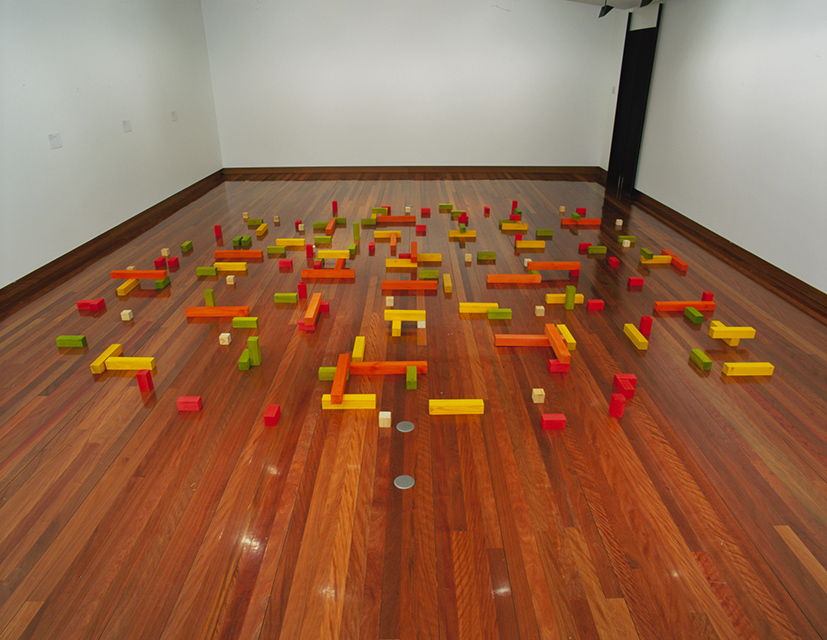


Andrew McQualter's installation pier and ocean (1997) tells a story about three patriarchs: Piet Mondrian, the Dutch modernist artist; Georges Cuisenaire, the Belgian inventor of education methods; and Jock McQualter, maths educator and father of Andrew.
Pier and ocean is a room-sized installation consisting of wooden rods coloured white, red, yellow, green and orange. They are gigantic versions of Cuisenaire rods. Cuisenaire rods are an education tool invented by Georges Cuisenaire and popularised in western primary schools in the 1960s. By playing with them, children could explore concepts such as whole numbers, basic arithmetic, measurement, symmetry and patterns. Cuisenaire rods were basically an abstraction that revealed the underlying structures of mathematical concepts in a physical form.
McQualter's premise is that, like Cuisenaire, Mondrian invented an abstraction that would reveal greater underlying truths to the viewer. The installation is based on Mondrian's Pier and Ocean series of 1914–15, which were studies of the ocean's surface. Mondrian sought to demonstrate the underlying structure of nature by abstracting it into lines and colours on canvas. Cuisenaire created an abstract system to demonstrate mathematical equations. Both innovators had their own utopian project: Mondrian’s was to represent the modernist sublime, and Cuisenaire's to create an education system for mathematics that could be used all over the world.
By making pier and ocean, McQualter has taken one abstraction of nature from the early modernist era and overlaid it with another, from many decades later. He has taken Mondrian's modernist sublime and imbued it with a tone of childhood familiarity; like many of his generation, McQualter was taught with the Cuisenaire method in primary school. His childhood memories are of the aesthetic of 1950s utopianism, which the cuisenaire rods symbolise.
In addition to Mondrian and Cuisenaire, McQualter alludes to a third patriarch. McQualter's father was a maths educator in Newcastle. He taught teachers how to teach maths.
Pier and ocean is a work about fathers. McQualter has said of the work, 'It's about loving your patriarch'.1 At the time of making pier and Ocean, McQualter was reading a catalogue from the exhibition, 'Letters from my father', by the New Zealand artist Richard Killeen. In the catalogue essay, 'Two signwriters, two fathers', Francis Pound talked about the influence of Killeen's biological father, the signwriter John Killeen, and his creative mentor artist, Colin McCahon. Pier and ocean represents McQualter's own thoughts on the influence of patriarchs in his life.
Pier and ocean brings together some of the fundamental themes in McQualter's œuvre: science, abstractions (artistic, scientific and educational) and utopian visions. For example, Vision statement (2000) was a large wall drawing of a tree trunk with branches and knots, dissected and labelled to represent the artist's journey through the art world. This work demonstrates McQualter's fascination with formations of nature and the way they can be used to demonstrate social systems.
McQualter's work is often diagrammatic. Sometimes they look like functional plans, at others like a child's toy or invention. His works often operate as a diagram of their own creation. This can make them appear didactic or analytical. At other times, the diagrammatic quality looks more like an economy of materials and techniques. This quality, particularly in the case of pier and ocean, is a result of McQualter's engagement with modernist reductivism. It is also a product of his preoccupation with the relationship between Mondrian and Cuisenaire's abstraction. Although his works are ambitious in scale and content, this is kept in check by the modesty of his materials, technique and style. He uses no more than what is necessary for the task or to demonstrate his point, which gives the work a pragmatic, sometimes thwarted look, despite their dream-like, utopian content.
A case in point is New design for outer space (1999). This work consisted of handmade spacecraft, suspended from the ceiling, and a wall drawing of an asteroid field. New design was like a child's construction and clearly unfit for use. At stake in McQualter's work is a tension between ambitious plans and an impulse to undermine them with playfulness and cynicism. While the utopian drive in his work is irrepressible it remains pure dreaming, with practicality and the likelihood of execution being limited to an aesthetic quality only. This is a self-consciously speculative art that invokes a struggle between the 'private' question of self and identity, and institutions (families, education, work) and their histories and discourses.
- Lara Travis
Andrew McQualter is represented in Australia by Daine Singer.